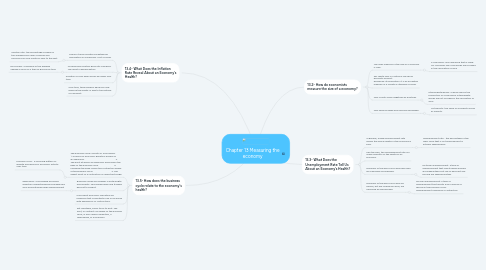
1. 13.2- How do economists measure the size of a economy?
1.1. The main measure of the size of a economy is GDP.
1.1.1. A final good- any new good that is ready for consumer use; final goods are included in the calculation of GDP
1.2. Per capita GDP is a nation's real gross domestic product divided by its population. It is an accepted measure of a society's standard of living.
1.3. GDP counts some negatives as positives.
1.3.1. intermediate goods- a good used in the production of a final good; intermediate goods are not included in the calculation of GDP.
1.4. GDP ignores illegal and informal exchanges.
1.4.1. net exports- the value of all exports minus all imports .
2. 13.3- What Does the Unemployment Rate Tell Us About an Economy’s Health?
2.1. In general, a high unemployment rate means the overall health of the economy is poor.
2.1.1. unemployment rate- the percentage of the labor force that is not employed but is actively seeking work
2.2. Like the GDP, the unemployment rate is a useful indicator of the health of an economy.
2.3. Members of the labor force who have jobs are classified as employed.
2.3.1. frictional unemployment- a type of unemployment that results when workers are seeking their first job or have left one job and are seeking another
2.4. Members of the labor force who are jobless, but are looking for work, are classified as unemployed.
2.4.1. cyclical unemployment: a type of unemployment that results from a period of decline in the business cycle; unemployment caused by a contraction
3. 13.4- What Does the Inflation Rate Reveal About an Economy’s Health?
3.1. The BLS tracks inflation by gathering information on Americans' cost of living.
3.1.1. inflation rate- the percentage increase in the average price level of goods and services from one month or year to the next
3.2. Occasionally inflation goes into overdrive. The result is hyperinflation.
3.2.1. price index- a measure of the average change in price of a type of good over time
3.3. Deflation occurs when prices go down over time.
3.4. Over time, technological advances may improve the quality or add to the lifetime of a product.
4. 13.5- How does the business cycle relate to the economy's health?
4.1. The business cycle consists of four phases. 1. A period of economic growth is known as an expansion. 2. The point at which an expansion ends marks the peak of the business cycle. 3. Following the peak comes the contraction phase of the business cycle. 4. The lowest point of a contraction is called the trough.
4.1.1. business cycle- a recurring pattern of growth and decline in economic activity over time
4.2. Business cycles are irregular in both length and severity. This makes peaks and troughs difficult to predict.
4.2.1. depression- a prolonged economic downturn characterized by plunging real GDP and extremely high unemployment
